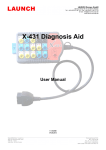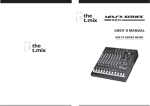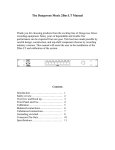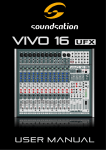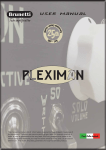Download USER` S MANUAL - Topp Pro Professional Audio Gear
Transcript
USER' S MANUAL NF03522-1.0 TABLE OF CONTENTS 1. INTRODUCTION.......................................................................1 2. FEATURES...............................................................................1 3. USEFUL DATA...........................................................................1 4. CONTROL ELEMENTS................................................................3 5. INSTALLATION TIPS ................................................................14 6. WIRE CONNECTIONS...... ........................................................15 7. BLOCK DIAGRAM ...................................................................16 8. TECHNICAL SPECIFICATION.....................................................18 9. GUARANTEE .........................................................................20 INTRODUCTION Thank you for purchasing the MX series MX.22 / 2FX & MX.26 / 2FX mixing console. The MX.22 / 2FX mixing console is packed with some features that can not be found in other consoles of its size: 4 mono (these are provided with ultra low noise microphone preamplifiers and phantom power at +48V) and 2 stereo input channels (4 channels for MX.26/2FX ) and each of them is provided with warm, natural EQ; 2-Track inputs assign-able to Main mix, Phones / Control Room outputs etc. Besides, the 24-bit effect processor with 256 effects. Please read this manual carefully so you can take advantages of all the features of the MX series. Thank you again for making the right choice in purchasing the TOPP PRO MUSIC GEAR. FEATURES 4 mono inputs with gold plated XLR and Balanced TRS jack 2 (4 for MX.26/2FX) stereo inputs with Balanced TRS jack GAIN control and +48V phantom power for mono inputs 3-band EQ (plus 75Hz low cut filter) on all mono channels (For MX.22/2FX) 3-band EQ with sweepable MID (plus 75Hz low cut filter) on all mono channels and 4-band EQ on stereo channels (For MX.26//2FX) 2 AUX sends: AUX1 with PRE / POST-fader switch for monitoring, AUX2 POST-fader for effect sends can be changed in PRE-fader for monitoring Each input channel features MUTE/ALT3-4, SOLO switches and OL LED (MX.22/2FX) MUTE, SUB1-2 and L-R assign switches, SOLO switches and OL LED (MX.26/2FX) 2-Track IN/OUT with discrete switches for routing to Control Room and to Main Mix Two different ways of SOLO PFL/AFL for a better control over signal path Balanced XLR & TRS jack output 24-bits internal DSP with 256 effects (16 presets by 16 variations), DSP MUTE & Peak LED USEFUL DATA Please write your serial number here for future reference. Serial Number: Data of Purchase: Purchased at: HOOKUP DIAGRAM STAGE MONITORS MIC1 MIC2 WIRELESS MONO IN/STEREO OUT MICROPHONE BEVER(OPTIONAL) MX . 26/2FX HEADPHONE MODEL SERIAL L 1 1 3 1 R 2 2 4 2 CTRL RM OUT SUB OUTS AUX SEND FOOTSW R L TIP SEND/RING RTN POWER MAIN OUTS(BAL/UNBAL) PHONES CHANNEL INSERTS USB PLAYER L L 00 MP3 MONO R R USB REP 03 :08 ALL TAC-MP3-T AUX RETURN GAIN GAIN 75Hz GAIN 75Hz GAIN 75Hz +4 -10 75Hz POWER (Push & Hold) FX RETURN +4 -10 +4 -10 LINE MP3 DRUM MACHINE CD PLAYER 1 MIC1 KEYBOARD MIC2 ACTIVE SPEAKERS DAT RECORDER WIRELESS MONO IN/STEREO OUT MICROPHONE BEVER(OPTIONAL) MX . 26/2FX HEADPHONE MODEL SERIAL FOOTSW R L 1 1 3 1 R 2 2 4 2 CTRL RM OUT SUB OUTS AUX SEND L TIP SEND/RING RTN POWER MAIN OUTS(BAL/UNBAL) PHONES CHANNEL INSERTS USB PLAYER L L 00 MP3 MONO R R USB REP 03 :08 ALL TAC-MP3-T AUX RETURN GAIN GAIN 75Hz GAIN 75Hz GAIN 75Hz 75Hz DI BOX GUITAR +4 -10 POWER (Push & Hold) FX RETURN +4 -10 +4 -10 LINE MP3 DIGITAL AUDIO INTERFACE KEYBOARD DIGITAL AUDIO WORKSTATION DRUM MACHINE ACTIVE STUDIO MONITORS CONTROL ELEMENTS FRONT PANEL 1- Mono MIC Input The MX series is equipped with 4 low-noise mic preamplifiers with optional phantom power providing up to 50 dB of amplification. You can connect almost any type of microphone. Dynamic microphones don't need phantom power. Use phantom power only with condenser microphones but make sure that the phantom power switch is disengaged before connecting the microphone. Phantom power will not damage your dynamic microphones but it may damage tube or ribbon microphones so make sure to read the microphone instructions manual before engaging phantom power switch. There are also equipped with 1 / 4" TRS balanced and TS unbalanced LINE IN plug, you can connect with line-level instruments, such as synthesizers, key-boards, drum machines or effect devices. NOTE: Never try to connect a line-level signal to the XLR MIC input when the phantom power is engaged, doing this you may seriously damage your equipment. 2- STEREO LINE INPUTS 1 3 4 GAIN 75Hz 2 LINE MP3 5 6 They are organized in stereo pair and provided with1/4" TRS jacks. It is used to connect the stereo device, plug both the left input and the right input. Using the left input if connect a mono input signal to the STEREO INPUT, the signal will appear on both sides. 3- GAIN CONTROL This GAIN control is used to control the input sensitivity of the MIC and LINE inputs. The adjustable range goes from 0 dB to 50 dB. 4- 75 Hz Low-Cut Switch By pressing this button you will activate a 75 Hz low frequency filter that cuts the bass frequency below 75 Hz. You can use this switch to reduce the hum noise caused by the mains power supply, or the stage rumble while using a microphone. 5- +4/-10 Switch +4/-10 switches are used to select the input sensitivity of the line inputs on the stereo channels. +4 dBu is suitable for professional audio devices and -10 dBv is suitable for general devices. If not sure to use which setting, try +4 dBu first, then change it to -10 dBv if the volume is too small to be satisfied. 6- LINE/MP3 Switch By pressing this button, it will switch to the MP3 mode, then the MP3 signal can be sent to this channel or the Main Mix channel; by releasing this button, LINE IN inputs signal will send to the line input channels. EQUALIZATION The MX.22 / 2FX is equipped with 3-band EQ on all the channels while the MX.26 / 2FX has 3-band EQ with sweepable MID on all mono channels and 4-band EQ on stereo channels. All bands provide up to 15 dB boost or cut. 7- HIGH This is the treble control. You can use it to get rid of high frequency of the human voice. The gain range goes from -15 dB to +15 dB with a centre frequency of 12 kHz. 3 CONTROL ELEMENTS 7 7 600 8 9 MID FREQ 100 MID 3kHz 9 MID 500Hz 9' 8k 9 10 10 MX.22/2FX MX.26/2FX 8- MID FREQ (Only for Mono Channels of MX.26/2FX) It can change the center frequency for the MID EQ filter. From this knob you can more accurately select the band of frequency that you want to boost or cut. The ranges goes from 100 Hz to 8 kHz. 9- MID EQ This control provides 15 dB boost or cut at 2.5 kHz on the MX.22/2FX. The MX.26/2FX has one sweepable MID EQ controls on the mono channels and two discrete MID EQ on the stereo channels with center frequencies at 3 kHz and 500 Hz(9'), the midrange frequencies include the upper male and lower female vocal ranges,and the fundamentals and harmonics for many instruments. 10- LOW EQ This is the bass control. It is used to boost male voice, kick-drum or bass guitar. Your system will sound much bigger than what it is. The gain range goes from -15 dB to +15 dB with a center frequency of 80 Hz. 11- AUX Send Controls These two controls are used to adjust the level of signal sent to AUX bus 1&2, and this adjustment doesn't effect the main mix output signal at all. AUX SEND1 ( MON ) can be configured as PRE / POST fader via the PRE switch. Up for POST fader, the signal is sent out after the channel fader and will be affected by the channel fader. Down for PRE fader, the signal is sent out before the channel fader and will not be affected by the channel fader. AUX 2 (FX) is configured as POST fader. 12- PAN/BAL Abbreviation of PANORAMA control for mono channels,for the stereo channels, always says, BALANCE control. You can adjust the stereo image of the signal via this control. For mono MIC / LINE channels, keep PAN control in centre position and your signal will be positioned in the middle of stage that is to say the mono signal appears equally in both sides. Turn this control fully counterclockwise and the signal will be present only on the left speaker and vice-versa. For stereo channels, by rotating the BAL control, you can attenuate the signal of left or right. It means if turn the control to left, the right channel will be attenuated; if turned to right, the left channel will be attenuated. 13- MUTE/ALT3-4 SWITCH (For MX.22/2FX) and MUTE SWITCH (For MX.26/2FX) Each channel is equipped with the MUTE / ALT3-4 ( in MX.22 / 2FX ) or MUTE switch ( in MX.26/2FX ). Pressing this switch is equal to turning the fader down, which can mute the corresponding channel output except for SOLO (in PFL mode), the MUTE LED will illuminate. In MX.22/2FX , the MUTE/ALT3-4 switch can also be used for signal routing. 4 CONTROL ELEMENTS 14- SOLO SWITCH & OL LED When pressing this switch, the OL LED will 11 illuminate and the SOLO signal will replace 11 other signals and reach to the CONTROL ROOM/ PHONES. Usually use the SOLO function to 12 12 preview each channel before they are get into the mix. You can solo more than one channel 13 13 at a time. And the soloed channels are sent to the CONTROL ROOM, PHONES, and LED display. Engaging the SOLO switch, all CONTROL ROOM 14 14 SOURCE selections MAIN MIX, CD/TAPE, ALT3-4 15 ( MX.22/2FX ) & SUB1-2 ( MX.26/2FX ) will be muted. 15- 1-2 & L-R Switches(only for MX.26/2FX) 16 16 Each channel provides two assignment switches: CH1 1-2, and L-R. Pressing the 1-2 will assign the CH1 MX.22/2FX MX.26/2FX channel signal to SUB1-2, you can depend on the PAN / BAL control to adjust the amount of channel signal sent to the SUB1 versus SUB2, when turns the PAN/BAL to completely left, then the signal can be only controlled by SUB1 and vice-versa. In the same way, pressing the L-R will assign the channel signal to MAIN MIX L-R. This switch must be engaged in to get the channel's signal through to main outs. PRE PRE MUTE MUTE ALT 10 OL OL 10 5 5 0 SOLO 0 1-2 5 -5 10 -10 L-R 20 -20 30 -30 40 50 60 SOLO -40 -50 -60 16- Fader This control will adjust the overall level of this channel and set the amount of signal sent to the 17 main output. SUB ASSIGN TO MAIN MIX 17- SUB ASSIGN TO MAIN MIX Switches (only for MX.26/2FX) Through these switches, you can operate the SUB1-2 faders as L R L R a master control for assigning the SUB 1-2 to MAIN MIX. Engage the LEFT switch to send the corresponding sub signal to MAIN MIX L, and the RIGHT switch for MAIN MIX R. When engaging the both switches, the signal will be sent to L/R of MAIN MIX. 18- ALT3-4 Master Faders (MX.22/2FX) & SUB1-2 Master Faders (MX.26/2FX) These faders are used to control the levels of signal that send to the ALT3-4OUT / SUB1-2 OUT. The range goes from - to MX.22/2FX +10 dB. By pushing in the MUTE/ ALT3-4 switch(for MX.22/2FX) & SUB 1-2 ASSIGN switch ( for MX.26/2FX ), the signals will appear at the ALT3-4/SUB1-2 OUTS. 12- INPUT 2 2BUS MIXER WITH DIGITAL EFFECTS 19- MAIN MIX Faders These two faders set the level of main mix signals sent to the Main Outputs, Tape Outputs, CONTROL ROOM, PHONES, and LED display. Note: When connecting a speaker to the speaker output jacks on rear panel, please pay more attention to the level setting for avoiding damaging the speaker. Generally, the faders will be positioned between 0 dB (U) & +5 dB. 20- MASTER AUX SEND Controls Both knobs are used to determine the master AUX SEND levels. The adjustable range is from - to +15 dB. When the external effect unit connected to mixer has no input gain control, you can get a further +15 dB gain available from these AUX SEND outputs. 5 10 10 10 10 5 5 5 5 0 0 0 0 5 5 5 5 10 10 10 10 20 20 20 20 30 30 30 30 40 50 60 40 50 60 40 50 60 40 50 60 ALT 3 ALT 4 MAIN MIX 18 19 MX.26/2FX 16-INPUT 2/2BUS MIXER WITH DIGITAL EFFECTS 10 10 10 10 5 5 5 5 0 0 0 0 -5 -5 -5 -5 -10 -10 -10 -10 -20 -20 -20 -20 -30 -30 -30 -30 -40 -50 -60 -40 -50 -60 -40 -50 -60 -40 -50 -60 SUB 1 SUB 2 18 MAIN MIX 19








